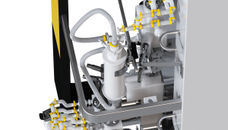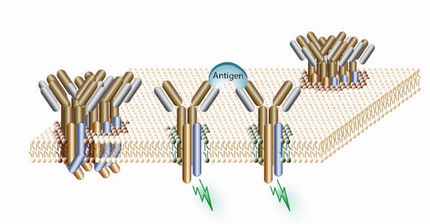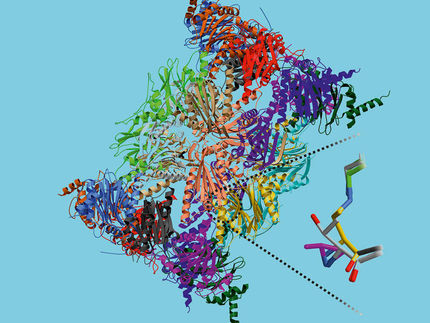Immune system assassin's tricks visualised for the first time
Scientists from the UK and Australia have seen the human immune system's assassin – a protein called perforin – in action for the first time. The UK team, funded by the biotechnology and Biological Sciences Research Council (BBSRC) and the Wellcome Trust, is based at Birkbeck College where they used powerful electron microscopes to study the mechanism that perforin uses to punch holes in rogue cells. The research is published in Nature .
Professor Helen Saibil, who leads the UK team at Birkbeck College, said "Perforin is a powerful bullet in the arsenal of our immune system – without it we could not deal with the thousands of rogue cells that turn up in our bodies through our lives."
"Perforin is our body's weapon of cleansing and death," said project leader Professor James Whisstock from Monash University, Melbourne, Australia.
Perforin works by punching holes in cells that have become cancerous or have been invaded by viruses. The holes let toxic enzymes into the cells, which then destroy them. If perforin isn't working properly the body can't fight infected cells. And there is evidence from mouse studies that defective perforin leads to an upsurge in malignancy, particularly leukaemia, so says Professor Joe Trapani, head of the Cancer Immunology Program at the Peter MacCallum Cancer Centre in Melbourne, Australia.
The first observations that the human immune system could punch holes in target cells was made by the Nobel Laureate Jules Bordet over 110 years ago, but we have had to wait for the latest advances in structural molecular biology to find out how exactly this happens.
Professor Saibil continued "From our previous work we already knew that bacterial toxins, such as the one involved in pneumonia, dramatically change shape to punch holes in membranes. We were fascinated by perforin and wanted to know its structure and how that might change in order for it to act as a hole-punching machine."
The structure was revealed by combining information about a single perforin molecule – visualised using the Australian Synchrotron – with Professor Saibil's electron microscope images, (taken in London), of a ring of perforin molecules clustered together to form a hole in a cell membrane.
Professor Whisstock added "Now we know how it works, we can start to fine tune it to fight cancer, malaria and diabetes."
Another interesting finding is that the important parts of the perforin molecule are quite similar to those toxins deployed by bacteria such as anthrax, listeria and streptococcus, showing that this method of making holes in cell membranes is quite ancient in evolution. "The molecular structure has survived for close to two billion years, we think," said Professor Trapani.
Perforin is also the culprit when the wrong cells are marked for elimination, either in autoimmune disease conditions, such as early onset diabetes, or in tissue rejection following bone marrow transplantation. So the researchers are now investigating ways to boost perforin for more effective cancer protection and therapy for acute diseases such as cerebral malaria. And with the help of a £600K grant from the Wellcome Trust they are working on potential inhibitors to suppress perforin and counter tissue rejection.
Professor Douglas Kell, BBSRC Chief Executive said "New technologies in microscopy and synchrotron experiments have opened up tremendous opportunities for molecular biologists. This is a great example where the knowledge we gain about the normal structure and function of a molecule has the potential to underpin important developments in our health and well being."
Most read news
Other news from the department science
These products might interest you

Hahnemühle LifeScience Catalogue Industry & Laboratory by Hahnemühle
Wide variety of Filter Papers for all Laboratory and Industrial Applications
Filtration Solutions in the Life Sciences, Chemical and Pharmaceutical Sectors

Hydrosart® Ultrafilter by Sartorius
Efficient ultrafiltration for biotech and pharma
Maximum flow rates and minimum protein loss with Hydrosart® membranes

Hydrosart® Microfilter by Sartorius
Hydrophilic microfilters for bioprocesses
Minimal protein adsorption and high flow rates

Sartopore® Platinum by Sartorius
Efficient filtration with minimal protein adsorption
Reduces rinsing volume by 95 % and offers 1 m² filtration area per 10"

Polyethersulfone Ultrafilter by Sartorius
Reliable filtration with PESU membranes
Perfect for biotechnology and pharmaceuticals, withstands sterilisation and high temperatures

Polyethersulfone Microfilter by Sartorius
Biotechnological filtration made easy
Highly stable 0.1 µm PESU membranes for maximum efficiency

Sartobind® Rapid A by Sartorius
Efficient chromatography with disposable membranes
Increase productivity and reduce costs with fast cycle times

Get the life science industry in your inbox
By submitting this form you agree that LUMITOS AG will send you the newsletter(s) selected above by email. Your data will not be passed on to third parties. Your data will be stored and processed in accordance with our data protection regulations. LUMITOS may contact you by email for the purpose of advertising or market and opinion surveys. You can revoke your consent at any time without giving reasons to LUMITOS AG, Ernst-Augustin-Str. 2, 12489 Berlin, Germany or by e-mail at revoke@lumitos.com with effect for the future. In addition, each email contains a link to unsubscribe from the corresponding newsletter.






















































